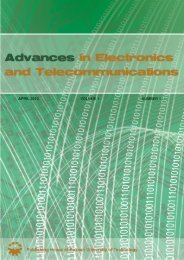november 2010 volume 1 number 2 - Advances in Electronics and ...
november 2010 volume 1 number 2 - Advances in Electronics and ...
november 2010 volume 1 number 2 - Advances in Electronics and ...
Create successful ePaper yourself
Turn your PDF publications into a flip-book with our unique Google optimized e-Paper software.
54 ADVANCES IN ELECTRONICS AND TELECOMMUNICATIONS, VOL. 1, NO. 2, NOVEMBER <strong>2010</strong><br />
TABLE II<br />
THE RESULTSOF NIST TESTSFOR CPRNG WITH λ = 7, α = 4,<br />
K=3<br />
Type of the test R(> 0.981) PT (> 0.0001) F<strong>in</strong>al result<br />
Block Frequency 0.9900 0.86288 pass<br />
Serial* 0.9870 0.13728 pass<br />
Approximate Entropy 0.9920 0.13112 pass<br />
L<strong>in</strong>ear Complexity 0.9920 0.68902 pass<br />
Universal 0.9850 0.00737 pass<br />
Overlapp<strong>in</strong>g<br />
Templates<br />
0.9900 0.16170 pass<br />
Non-overlapp<strong>in</strong>g<br />
Templates*<br />
0.9820 0.02979 pass<br />
Cumulative Sums* 0.9840 0.67661 pass<br />
Runs 0.9860 0.04198 pass<br />
Longest Runs of Ones 0.9930 0.89348 pass<br />
Rank 0.9950 0.96019 pass<br />
Spectral DFT 0.9880 0.26757 pass<br />
R<strong>and</strong>om Excursions* 0.9865 0.31094 pass<br />
R<strong>and</strong>om Excursions<br />
Variant**<br />
0.9828 0.09676 pass<br />
Frequency 0.9870 0.93900 pass<br />
*This test consists of several subtests: the worst result is shown.<br />
**The m<strong>in</strong>imum pass rate for this test for a st<strong>and</strong>ard set of parameters is<br />
approximately 0.978.<br />
pliers λ enables us to construct a high-speed pseudor<strong>and</strong>om<br />
generatorwithlongperiodsofgeneratedstreams. Thesimplest<br />
method uses a field programmable gate array (FPGA). In this<br />
circuit, we implement r CPRNGs with different values of λ<br />
that work <strong>in</strong> parallel. In each step of generation, we obta<strong>in</strong> r<br />
pseudor<strong>and</strong>om<strong>number</strong>s.Consequently,the speedof produc<strong>in</strong>g<br />
pseudor<strong>and</strong>om <strong>number</strong>s <strong>in</strong>creases r times. This property can<br />
be used <strong>in</strong> cryptography <strong>and</strong> <strong>in</strong> multi-core processors for fast<br />
generation of high-quality pseudor<strong>and</strong>om <strong>number</strong>s with long<br />
periods.<br />
REFERENCES<br />
[1] P. Bratley, B. L. Fox, <strong>and</strong> L. E. Schrage, A Guide to Simulation. New<br />
York: Spr<strong>in</strong>ger-Verlag, 1987, ch. 6.<br />
[2] J. E. Gentle, R<strong>and</strong>om Number Generation <strong>and</strong> Monte Carlo Methods.<br />
New York: Spr<strong>in</strong>ger, 2003, ch. 1.<br />
[3] D. E. Knuth, The Art of Computer Programm<strong>in</strong>g, 2nd ed. Addison<br />
Wesley, 1981, vol. 2, ch. 3.<br />
[4] [onl<strong>in</strong>e], http://csrc.nist.gov/rng/.<br />
[5] F. Gebhard, “Generat<strong>in</strong>g pseudo-r<strong>and</strong>om <strong>number</strong>s by shuffl<strong>in</strong>g a Fibonacci<br />
sequence,” Mathematics of Computation, vol. 21, pp. 708–709,<br />
1967.<br />
[6] C. Bays <strong>and</strong> S. D. Durham, “Improv<strong>in</strong>g a poor r<strong>and</strong>om <strong>number</strong> generator,”<br />
ACM Trans. on Mathematical Software, vol. 2, pp. 59–64, 1976.<br />
[7] M. P. Kennedy, R. Rovatti, <strong>and</strong> G. Setti, Chaotic <strong>Electronics</strong> <strong>in</strong> Telecommunications.<br />
Boca Raton: CRC Press, 2000, ch. 3.<br />
[8] L. Kocarev, G. Jakimoski, <strong>and</strong> Z.Tasev, Chaos <strong>and</strong> Pseudo-R<strong>and</strong>omness<br />
<strong>in</strong> Chaos Control, 2003, pp. 247–263.<br />
[9] T.Kohda <strong>and</strong> A. Tsuneda, “Statistics of chaotic b<strong>in</strong>ary sequences,” IEEE<br />
Trans. Inf. Theory, vol. 43, pp. 104–112, Jan. 1997.<br />
[10] T. Stojanovski <strong>and</strong> L.Kocarev, “Chaos-based r<strong>and</strong>om <strong>number</strong> generators<br />
– Part I: Analysis,” IEEE Trans. Circuits Syst. I, vol. 48, pp. 281–288,<br />
Mar. 2001.<br />
[11] M. Jessa, “Design<strong>in</strong>g security for <strong>number</strong> sequences generated by means<br />
of the sawtooth chaotic map,” IEEE Trans. Circuits Syst. I, vol. 53, pp.<br />
1140–1150, May 2006.<br />
Mieczyslaw Jessa was born <strong>in</strong> Pol<strong>and</strong> <strong>in</strong> 1961. He received the M.Sc. degree<br />
with honors from Poznan University of Technology <strong>in</strong> 1985 <strong>and</strong> the Ph.D.<br />
degree <strong>in</strong> 1992 from the same University. S<strong>in</strong>ce 1985 he has been employed<br />
at the Institute of <strong>Electronics</strong> <strong>and</strong> Telecommunications <strong>in</strong> Poznan. Now, he<br />
works with the Chair of Telecommunication Systems <strong>and</strong> Optoelectronics of<br />
the same University.<br />
Initially, his research <strong>in</strong>terest <strong>in</strong>cluded phase-locked loops <strong>and</strong> PDH/SDH<br />
network synchronization. In the years 1995-1997 he was an expert of Polish<br />
M<strong>in</strong>istry of Communications <strong>in</strong> the field of digital network synchronization.<br />
His current research concerns r<strong>and</strong>omness <strong>and</strong> pseudo-r<strong>and</strong>omness, the applications<br />
of the chaos phenomenon, <strong>and</strong> mathematical models of systems<br />
evolution. He is the author or co-author of over one hundred journal <strong>and</strong><br />
conference papers <strong>and</strong> fifteen patents.







